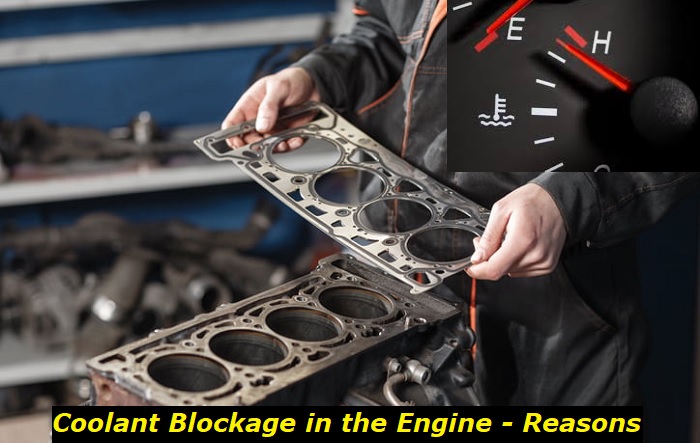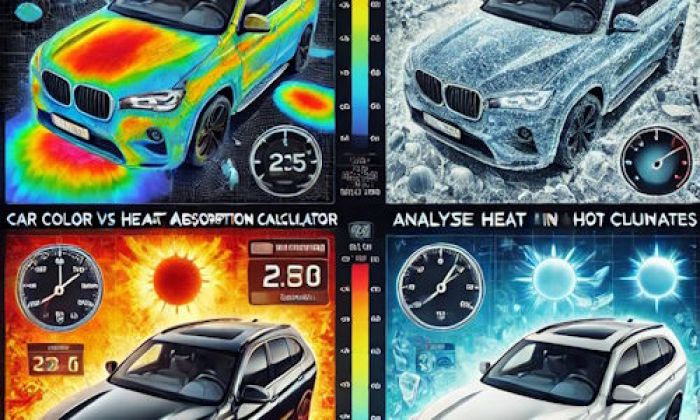The coolant that is circulating inside your engine is one of the most important systems to keep your engine functioning. The combusting fuel and the friction between the moving components of your engine create immense amounts of heat. The only thing that is keeping your engine from overheating is your coolant.
Coolant circulation problems highlights
- Level of urgency:medium
- Commonreasons:bad coolant, air lock, thermostat issues
- DIY diagnostics:complicated
- DIY repair:impossible
- Price of repair:$250 - $650
- Time for repair:2 - 7 hours
- If ignored:fatal overheating and engine damage

Symptoms Of Coolant Blockage In The Engine
There are certain symptoms that you should be able to see when you are facing a coolant blockage in the engine. The sooner you identify these symptoms, the easier it is to get your coolant blockage fixed.
1) High Engine Temperature
The coolant keeps your engine temperature in the optimal range. So obviously, when there is a coolant blockage in the engine, you would see a spike in engine temperature. Your thermostat will alert you when your engine temperature is high, and the warning light would immediately light up in your dash. There can be many reasons why your engine might be overheating, and a coolant blockage is one of them.
The ideal engine temperature when you are driving should be around 195°F to 220°F. A slight deviation from this range is nothing to worry about. If your engine warning light illuminates, that is when you should be worried.
2) Coolant Leaks
This is a direct result of pressure build-up when there is a coolant blockage in the engine. Even though your coolant lines are blocked, your water pump will still try to pump coolant in order to keep it circulating in the engine. So, at the place of the blockage, the pressure increases. This could rupture pipes or cause coolant to leak through the tiniest openings in the system. Once this happens you should be able to see coolant leaking both when you are driving and when your vehicle is idle. So, sooner rather than later, you would run out of coolant which again will result in an overheating engine.
Coolant leaks are quite easy to spot as they leave liquid puddles under your car. But out of the many liquids within your car, how exactly do you identify a coolant leak? Coolant is usually a bright green color fluid. This bright green color is designated for the coolant to make it easier to identify. And when there are leaks, you'll often find a puddle in the front end of your car. As the coolant circulates around your engine, any leaks will also be close to the engine.
Other than visible leaks, your car will also warn you when the coolant level is low. If you are regularly getting this warning, obviously there is a leak in the system.
3) Fluid Discoloration
As mentioned above, the coolant fluid comes out of the factory as a bright green color fluid. It is recommended that you replace your coolant every 30,000 miles. If you fail to do so, your coolant fluid will start to change color. Within no time, it will turn brown and dirty.
The color of your coolant changes because of the dirt that is accumulated in the coolant. And this dirt will eventually start settling in your hoses and other parts of your engine's cooling system. Which will eventually lead to a coolant blockage in the engine.
4) Exterior Clogging
Sometimes this kind of thing can be caused by things that are not inside the system but rather by forces acting on it from the outside.
The radiator fins have a main role in letting in airflow to the hot coolant that passes behind. But sometimes you can have sticks, dirt, and other debris clogged in the radiant fins causing the airflow to be blocked. Meaning that the same hot coolant is going to be flowing through the cooling system, making your vehicle overheat very quickly.
5) Cold Lower Hose
If your radiator is working perfectly you should be able to notice that your top radiator hose is hot to the touch and your lower radiator hose is warm to the touch.
If after driving for a while you notice that your lower house is cold it may signal that your radiator is under some kind of blockage and the full flow of coolant is not getting to the water pump.
Consequences Of Coolant Blockage In The Engine
The coolant that is flowing through the engine is basically the lifeblood of the engine. Without it, the engine will suffer. Along with the engine, many other functions of your vehicle will fail. These are some of the consequences of a coolant blockage in the engine.
1) Engine Damage
As mentioned earlier, if there is coolant blockage in the engine, the engine will surely overheat. But how bad is an overheating engine? Your engine is not supposed to overheat when operating under normal conditions. But occasionally it does overheat. If it happens once or twice, no big deal. But if you have a coolant blockage, your engine will overheat regularly. Especially, if you are putting stress on your engine by driving at high RPMs or towing heavy loads. So when your engine overheats regularly, it would end up damaging the cylinder head, gaskets, valves, and pistons.
In some vehicles, if your engine overheats, the vehicle will go into limp mode or shut down completely. That is meant to protect the engine from damages suffered from overheating. But if your vehicle doesn't have any of those features, and you continue to drive with an overheating engine, the damages suffered by the engine can be catastrophic. It could cause your engine to seize up and your only option would be to replace the entire engine.
2) Bursting Hoses
When there is a blockage the pressure builds up within the coolant system as the water pump continues to pump the coolant. It does cause coolant leaks, but that is much better compared to bursting hoses. If your hoses cannot contain the pressure due to the coolant blockage, it could end up bursting. There have been many accidents and burns reported due to bursting coolant hoses.
3) Heater Failure
The coolant that circulates your engine is also responsible for heating your cabin. And when the coolant circulation is disrupted due to coolant blockage in the engine, your cabin heating system will also fail. Either you won't get enough heat coming through the vents or your heating system will not work altogether.
What Is The Cause Of Coolant Blockage In The Engine
There can be many reasons behind a coolant blockage in the engine. Here are some of the common causes.
1) Deposits
Mineral deposits are the result of not replacing your coolant at the right interval. Your coolant needs to be bled and replaced every 30,000 miles. Failure to do so can result in minerals and other impurities clogging up the coolant system.
Similarly, rust could also result in clogs within the system. This too is the result of a lack of maintenance of the cooling system.
2) Air Pockets
Air pockets are a result of air leaks into the system or the use of improper techniques during maintenance and bleeding of the cooling system. Once air is trapped within the system, it can hinder circulation causing a coolant blockage in the engine.
3) Thermostat Failure
The thermostat regulates the flow of coolant to the engine. If the thermostat fails, it may send incorrect readings to the ECU. Without the proper data, the cooling system might not work when needed. Even a failure in the mechanism where the thermostat fails to open could cause a blockage in the system.
4) Water Pump Failure
The water pump is the heart of the entire operation of the cooling system. If the water pump fails, the entire cooling system will be crippled and the engine will not get the necessary supply of coolant.
How To Fix A Coolant Blockage To The Engine
Fixing a coolant blockage in the engine starts by finding the exact cause of the problem. A quick inspection should let you know exactly where the blockage is. Inspect the hoses, water pump, thermostat, and other components in order to find the exact area of the clog.
More often than not, bleeding the coolant and replacing it with a new batch should solve your problem. If the problem is caused by rust, mineral deposits, or other impurities within the system, replacing the coolant should solve the problem.
If that doesn't work, you'd have to address other components individually. If you've already found the source of the problem, you just take that part apart and clear the blockage. If not, you'd have to take apart the entire cooling system and inspect every part individually.
You could also use specialized chemical cleaners to remove the blockage from the engine. There are cleaners that can dissolve and other deposits to clear your coolant lines.
Conclusion
Coolant blockage in the engine is one of the worse problems you can run into. And the potential consequences are severe. But as long as you are aware of the symptoms, you can easily identify the problem at its early stages and fix the problem without making a fuss out of it.
About the authors
The CarAraC research team is composed of seasoned auto mechanics and automotive industry professionals, including individuals with advanced degrees and certifications in their field. Our team members boast prestigious credentials, reflecting their extensive knowledge and skills. These qualifications include: IMI: Institute of the Motor Industry, ASE-Certified Master Automobile Technicians; Coventry University, Graduate of MA in Automotive Journalism; Politecnico di Torino, Italy, MS Automotive Engineering; Ss. Cyril and Methodius University in Skopje, Mechanical University in Skopje; TOC Automotive College; DHA Suffa University, Department of Mechanical Engineering






Add comment